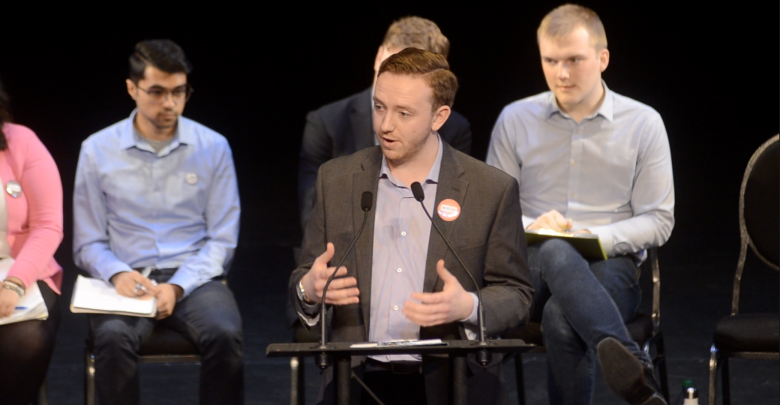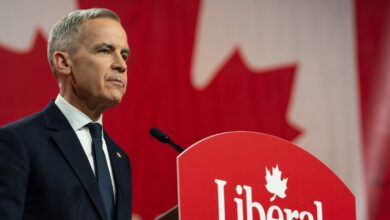 Oumar Salifou
Oumar Salifou Each year, The Gateway publishes an evaluation of the Students’ Union Executive and the Board of Governors representative. It’s impossible to discuss every aspect of their tenures, so these reports are largely based on the major components of the platform each executive campaigned on, and the most significant responsibilities of their respective positions. These evaluations were informed by interviews with the executives themselves. The grading rubric can be found below. And if you’re short for time, check out our TLDR for a bite-sized breakdown.
Adam Brown: D+
The role of the vice-president external can be hard for students to see, because their main job is to advocate to the government — outside of campus. However, this doesn’t mean they can’t engage with students. In fact, as the student mouthpiece, they should get the opinions of the people who are really on campus. Adam Brown, however, has been too busy this year to do much of either of those things.
Brown chairs the Canadian Alliance of Student Associations (CASA), which is exactly what it sounds like. This requires him to be off-campus even more than the average vice-president (external), but it shouldn’t render him unable to complete the most basic aspects of his role. While working with CASA can be beneficial in times of national political unrest, the problem is provincial at the moment. With the UCP cutting funding left and right for universities, the focus this year should have been local — and it wasn’t. According to Brown and other sources in the SU executive, voluntary student unionism wasn’t even mentioned to the UCP this year in advocacy efforts.
When asked about his engagement with students on campus this year, which was a huge point in his campaign last year, Brown simply responded, “I tried to be a lot more public with students this year.” He then went on to lament the difficulties of interacting with students as a vice-president (external), and said that his idea of allowing the role to fundraise would render his successors more capable of staying on campus in the future.
Here’s the thing: being public with students does not equal student engagement. This kind of interaction is only skin-deep. Though he marched with the Students Not Silent group in November, his attention has otherwise been elsewhere almost all year. According to Brown, CASA turned over virtually their entire office in Ottawa, and so he had to be there to oversee staffing, interviews, and just making sure the organization ran smoothly. He said that “if CASA isn’t running effectively, then our federal voice… isn’t working effectively.” But again: we needed to focus on provincial advocacy this year, and that’s something he and the rest of the SU executive should have seen and even predicted even before the UCP won the 2019 election. Federal advocacy can only help us so much when the tuition freeze is broken, or when the University of Alberta is losing millions of dollars.
Brown also said last year in his platform that he wanted to increase the number of non-repayable grants for students. Not only is this unrealistic, but he dangled this carrot even in his interview. When asked about the grants, he said, “feel free to check back in when [the provincial budgets] are released.” I suppose we can’t know for sure if he’s completed this goal, but it seems unlikely.
The big fish Brown wanted to fry this year was the ability of the vice-president (external) to fundraise. He said “it’s very important to lay the base,” but failed to elaborate on what exactly this base was. He then went on to mention SUTV and the SU’s website design, both of which were not his projects. Like some of his contemporaries, he also spoke about supposed endless “discussions” he was having to the end of actualizing this plan.
TLDR: Brown spent too much time focusing on CASA this year, and not enough time advocating for students on a desperately necessary provincial level. He overpromised on several platform points, but also failed to carry through on his basic task of representing students in their time of need. Students have been assaulted on all fronts by the government this year, and he failed to alleviate that pain. His work with CASA is the only thing pulling him through, but even that is not for the explicit benefit of the U of A. The next vice-president (external) needs to take this example and put effort into the appropriate ventures.
A-range: This person has fulfilled the promises they campaigned on and more, has created tangible change during their tenure, and has shown a commitment to improving the lives of students. Their GPA is top tier.
B-range: This person has done their job consistently well, but has not made any remarkable changes, or has fallen short on important goals they set out in their platforms. They’re doing fine, but it’s nothing to phone home about.
C-range: This person has done their job sufficiently, but has failed to make significant progress in the areas most relevant to their portfolio, or has essentially abandoned a major part of their platform. They’re still passing with a safe buffer though, and Cs get degrees!
D-range: This person has done a very lacklustre job, and has not sufficiently fulfilled their campaign promises or the responsibilities of their position.
F-range: This person has not done their job, has not represented students, and has not fulfilled their campaign promises whatsoever.




